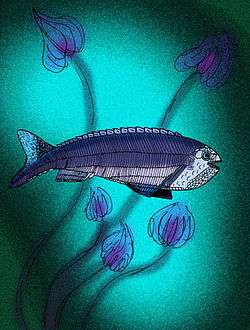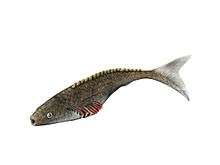Anaspida
| Anaspida Temporal range: 444–419 Ma Early Silurian - Early Devonian | |
|---|---|
 | |
| Cowielepis | |
| Scientific classification | |
| Kingdom: | Animalia |
| Phylum: | Chordata |
| Clade: | Craniata |
| Subphylum: | Vertebrata |
| Class: | †Anaspida Traquair, 1899 |
| Orders | |
| |

Anaspida ("without shield") is an extinct group of primitive jawless vertebrates that lived primarily during the Silurian period, and became extinct soon after the start of the Devonian.[2] They were once classically regarded as the ancestors of lampreys.[3] Anaspids were small marine agnathans that lacked heavy bony shield and paired fins, but have a striking highly hypocercal tail. They first appeared in the early Silurian, and flourished until the early Devonian, where they then disappear from the fossil record.
Anatomy
Compared to other prehistoric agnathan groups, such as the Heterostraci and Osteostraci, anaspids did not possess a bony shield or armor, hence their name. The anaspid head and body are instead covered in an array of small, weakly mineralized scales, with a row of massive scutes running down the back, and at least confirmed among the birkeniids, the body was covered in rows of tile-like scales made of aspidine.[4] Anaspids all had prominent, laterally placed eyes with no sclerotic ring, with the gills opened as a row of holes along either side of the animal, typically numbering anywhere from 6-15 pairs. The major synapomorphy for the anaspids is the large, tri-radiate spine behind the series of the gill openings.[1]
Phylogeny and taxonomy
Now that Jamoytius and its close cohorts, i.e., Euphanerops, have been moved to Jamoytiiformes,[5] Class Anaspida now comprises two orders, the monogeneric Lasaniida, which contains the genus Lasanius and represents a basal anaspid group,[6] and Birkeniida, which contains all other recognized anaspid taxa.[7] Birkeniida is further divided into several families, including Birkeniidae, Pterygolepididae, Rhyncholepididae and Pharyngolepididae, which contain those taxa known from whole body fossils (in addition to several taxa known only from scales) and the family Septentrioniidae, whose subtaxa are known exclusively from scales.[7] Two recently described genera, Kerreralepis[6] and Cowielepis,[8] are considered to be Birkeniida incertae sedis.

Notes
- 1 2 Janvier, Philippe (1997) Anaspida The Tree of Life Web Project.
- ↑ Ahlberg, Per Erik (2001). Major events in early vertebrate evolution: palaeontology, phylogeny, genetics, and development. Washington, DC: Taylor & Francis. p. 188. ISBN 0-415-23370-4.
- ↑ Patterson, Colin (1987). Molecules and morphology in evolution: conflict or compromise?. Cambridge, UK: Cambridge University Press. p. 142. ISBN 0-521-32271-5.
- ↑ Janvier, Philippe (2003). Early Vertebrates. Oxford University Press. ISBN 978-0-19-852646-9.
- ↑ Sansom, Robert S., et al. "Taphonomy and affinity of an enigmatic Silurian vertebrate, Jamoytius kerwoodi White." Palaeontology 53.6 (2010): 1393-1409.
- 1 2 Blom, Henning. "New birkeniid anaspid from the Lower Devonian of Scotland and its phylogenetic implications." Palaeontology 55.3 (2012): 641-652.
- 1 2 Blom, Henning, T. Märss, and C. G. Miller. "Silurian and earliest Devonian birkeniid anaspids from the Northern Hemisphere." Earth and Environmental Science Transactions of the Royal Society of Edinburgh 92.03 (2001): 263-323.
- ↑ Blom, Henning. "A new anaspid fish from the Middle Silurian Cowie Harbour fish bed of Stonehaven, Scotland." Journal of Vertebrate Paleontology 28.3 (2008): 594-600.
External links
- "The Anaspida - unarmoured "ostracoderms"". Palaeos: Life Through Deep Time. Retrieved 2012-11-24. External link in
|publisher=(help) - Monroe M. H. "Anaspida "no shield"". Australia: The Land Where Time Began. Retrieved 2012-11-24. External link in
|publisher=(help)